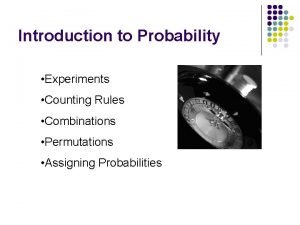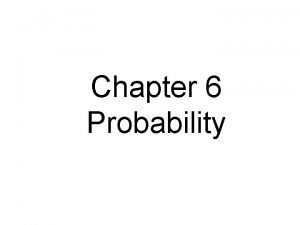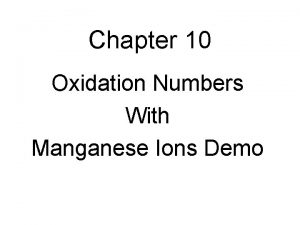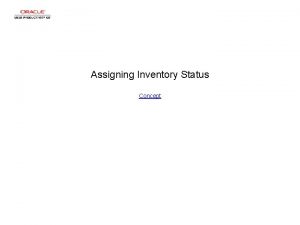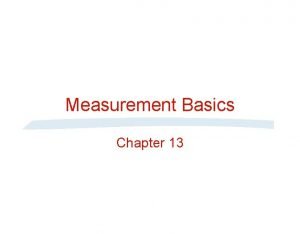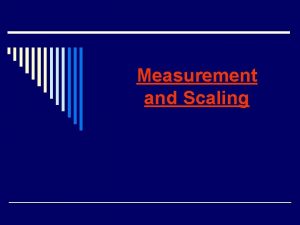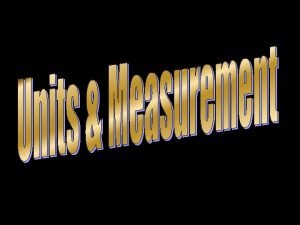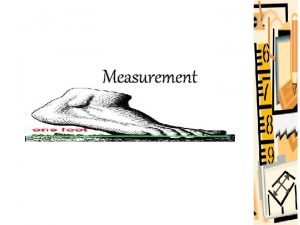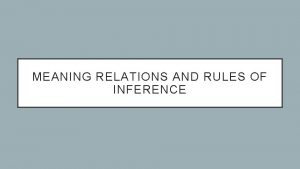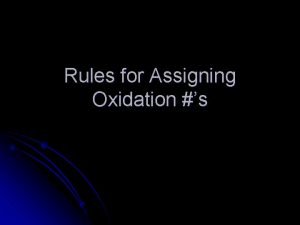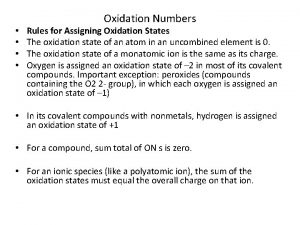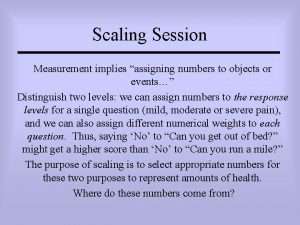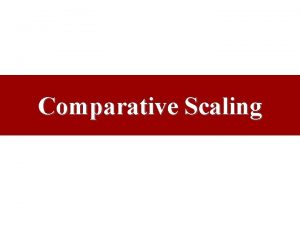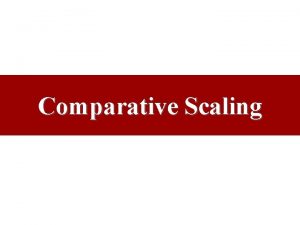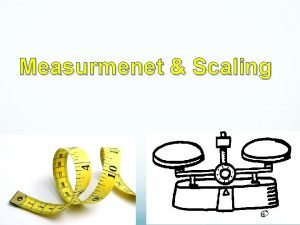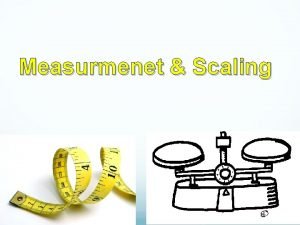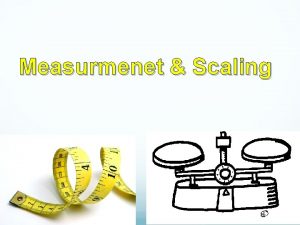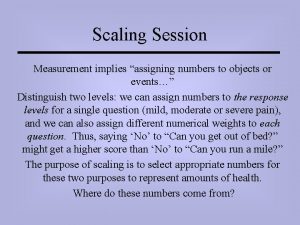Measurement Meaning Measurement consists of rules for assigning


















































- Slides: 50

Measurement • Meaning: Measurement consists of rules for assigning numbers to objects, the level of measurement being a function of the rulesunder which the numbers are assigned. eg: rule may be equal interval or interrelationship. • Formal properties of measurement: -Measurement is of attributes ie attributes of an object. It is not measurement of persons but the attributes and qualifications related to them.

• Attributes measure persons income, social class, education, behaviour, attitudes, feeling, convictions, biases, inclinations, declination setc. • Measurement consists of pieces of information that have application in many different places and times.

• Measurement is a process of mapping aspects of domain onto other aspects of a range according to rule of correspondence. • Eg: To find out the male to female ratio while conducting a study of people who attend a show. • Syntactics – relationship among signs 2+2=4 • Semantics-relationship between signs and objects it is the truth of assertion and giving meaning to abstract system. eg: Ravi is 3 years greater than Sonu. • Pragmatics-relationship between signs and users of signs. Making judgement on the realtionship. Ravi is elder than sonu.

Measurement Scales Nominal scales A system of assigning numbers or symbols to events in order to label them. Assignment of numbers of basketball players in order to identify them. The nos: are just convenient labels for the particular class of events and have no quantitative value.

Ordinal data • Places events in order , but there is no attempt to make the intervals of the scale equal interms of some rule. • The real differences between adjacent ranks may not be equal • Implies a statement of greater than or less than without telling howmuch greater or less.

Two college students asked to rank their activities at a shopping mall from favorite to least favorite. • Activity Jack Victoria • Shopping 4 1 • Socializing 5 3 • Walking 1 2 • Eating 2 4 • Watching 3 5 other people Jack ‘s and victoria’s favourite activity and least favorite activity and also shows intermediate preferences. Demerit: we do not know whether the diffrence between Jacks dislikes and victorias dislikes are

Interval scales • Rank characteristics using equal increments between ranking points equal. • Can have an arbitrary zero but no absolute zero. Eg: thermometer. • Eg: we want to know to how A, B, C, D respond to the statement “Advertising cigarettes on Television is fine me”, using the scale 1=strongly agree, 2=agree, 3=neither agree nor disagree, 4= disagree 5=strongly disagree • A-2 • B-1 • C-4 • D-5 • We can say that difference between A&B’s score is same as that of Diffrence between C&D’s scores

Ratio scales • Have an absolute or true zero. • Eg: no: of minor traffic rule violations &numbers incorrect letters in a page of type script. • If A’s typing error is 40% and B’s typing error is 80%, can say that A ‘s typing performance is twice is as good as B.


Sources of error in measurement • Respondent : may be reluctant to express strong negative feelings or may have very little knowledge. • Situation: any condition which places astrain on interview can have serious effect on the interviewer • Measurer: the interviewer can himself distort responses by rewarding or reordering questions • Instrument: defective measuring instrument through use of complex words, poor printing, inadequate space.

Scaling techniques • Scale is a continuum, consisting of the highest point and the lowest point along with the intermediate points between these 2 extremes are intermediate points • Scaling results in valid measurement

Scaling methods/techniques • Types of scales Comparitive rating scales Paired comparison rank order Non-comparitive rating scales Graphic rating Itemized rating constant sum Q-Sort Likert Semantic differential stapel

Comparitive rating scales • Respondents compare one characteristic or attribute against a specific standard , according to some predetermined criterion. So the standard of comparison is specified, researchers have a reference point. For eg: if want to know how Americans perceive the quality of mercedes, they may ask respondents to compare the quality of mercedes to

Non-Comparitive rating scales • Respondents are not given a reference point but have their own standards. For Eg: researchers may ask a sample group of Americans to rate the quality of Mercedes cars using a five point scale.

PAIRED COMPARISON • Respondents note their preference between items in paired sets. • The no: of required comparison =n(n-1)/2 RANK ORDER SCALES • Respondents rank products according to some predetermined criterion like quality , taste, style, attractive

Frequency of ranking Brand I II IV LEVIS 6 3 1 2 WRANG 2 LER 2 6 2 BUGLE BOY 1 2 4 5 LEE’S 3 5 1 3

CONSTANT SUM SCALES • Respondents allocate a predetermined number of rating points(typically 100) among several items, according to some criterion, to indicate the relative preferenceor imporatnce of each item compared to all others on the list RESTAURANT POINTS MCDONALDS ____ BURGER KING ____ HARDEES ____ TACO BELL ____ ARBY’S ____ KFC ____

Q-SORT • Limits large group of items in a relatively short time. • A sample is asked to indicate their preferences from a list of 80 slogans printed on several cards • Step: 1 using the 5 point most prefer, somewhat like, neutral, somewhat dislike , least prefer, choose slogans you most prefer and stack those cards under the most prefer category • From remaining 70, put 10 you least prefer in last prefer category and so on

Non-comparitive rating scales • Graphic rating scales • The respondents indicate their responses on a continuum. • There may be a blank straight line, or designated points

Itemized Rating Scale • Respondents select from a finite number of choices rather than from theoretically infinite number on a continuum. Likert scale • Also known as summated rating scale. • Respondents select from choice ranging from “strongly agree” to “strongly disagree • All favorable responses should be represented by high scores and unfavorable responses by low scores • If the questions are negative, the scores have to be reversed.

Semantic differential scale • Five or seven point itemized ordinal scale with dichotomous (opposite) pairs of descriptive words or phrases regarding the 2 extremes and a neutral midpoint. Stapel scale Similar to semantic differential except that instead of using 2 dichotomous descriptive words, only on word or phrase is used.

Thurstone differential • Also called as Thurstone’s equal appearing intervals. • A large no: of statements (100 to 200) are developed relating to the attitude to be measured. • These statements are arranged in such a manner that the most unfavourable statement are kept in pile one and neutral statement in pile six and most favourable statement in pile eleven. The frequency distribution of ratings for each statement are studied and widely scattered ratings are eliminated.

• Scale value of each of the remaining statement is determined. • Items with narrowest range of ratings are preferred for selection as being the most reliable. • Eg: A. All newspaper ads should be banned by law B. Reading newspaper ads is a complete wastage of time. C. Newspaper ads are monotonous D. Most of the newspaper ads are pretty bad E. Newspaper ads do not interfere too much with the reading of news. F. I have no opinion for or against the newspaper ads G. I like newspaper ads at times

H. Most newspaper ads are fairly interesting I. I like to buy products advertised in newspaers whenever possible J. Most newspaper ads help people select the best product available K. Newspaper ads are more fun to read than the regular news items.

Designing itemized rating scales • How many choices should be included? • Should the scale have an even or odd no: of choices? • Should the scale have the same no: of favourable or unfavourable choices? • Should the scale have a “no response” or “don’t know”?

Measurement Accuracy/Objectivity In Research Assessing Measurement Instruments RELIABILITY Alternative forms Internal Consistency VALIDITY Test-retest

validity content Criterion-related construct concurrent predictive convergent discriminant

• Measurement results=True measurement +measurement error. Measurement Error Systematic error Random error

• Systematic error is caused by constant error or bias in the implementation of measurement situation. • Encompasses all types of error except sampling error. Also known as sampling error • Random error : error caused by sampling method.

RELIABILITY - Ability of scale to produce consistent results if repeated measurements are taken. I Test-retest • Repeatedly tests an individual or group using the same or a similar scale each time under comparable conditions • Drawbacks 1. Difficult persuasion 2. Carryover effect 3. Non measurable repeatedly 4. Time constraints 5. Environmental change

II. ALTERNATIVE FORMS OF RELIABILITY • Uses two equivalent scales that are perceived by respondents to be different but that measure same content. • If the responses for both scales are high then reliability is also high. III. INTERNAL CONSISTENCY RELIABILITY • Two measurements one positive and other negative of same concept at the same time and then examines the correlation of the measurements. • SPLIT HALF TECHNIQUE • COEFFICIENT ALPHA

Ways to improve reliability 1. Increase the number of measurements 2. Use good experimental controls VALIDITY Degree to which a test measures what it is supposed to measure. I. CONTENT VALIDITY: Extent to which a measuring instrument provides adequate coverage of the topics under study.

II. CRITERION VALIDITY Ability of a sacle to perform as predicted to a specified criterion. EG: GMAT is taken to determine the applicants potential for success in the program. The focus is how well the predictor determines the applicants potential for success in the programme. • Aptitude tests • Past work experience • Personal income • Type of magazines. • Level of education

II a Concurrent Validity • How well a result from one score correspond with the results from anotherwhen the scales measure the same phenomenon at the same point of time. II b Predictive Validity How well a score predicts the occurrence of a future event

III. Construct Validity • How well an observable phenomenon determines an unobservable phenomenon. III a. Convergent Validity • Ability of a scale to correlate with other scale to purport to measure the same concept. • The logic is 2 or more measurements using different scales should highly agree.

III b DISCRIMINANT VALIDITY • It is a scale’s lack of correlation with another scale that purports to measure different concepts. • The result of two scales measuring unrelated concepts should display no correlation.

SCALE CONSTRUCTION TECHNIQUES Name of the scale Construction approach 1. Arbitrary Approach 2. Consensus Scale approach 3. Item analysis approach Name of the scales developed 1. Arbitrary scales(check list , rank order) 2. Differential scales (thurstone diffrential, Q-sort) 3. Summated Scales(Likert scale)

4. Cumulative Scales approach (Guttman’s Scalogram) 5. Factor Analysis approach 5. Factor scales (Osgood’s Semantic Differential, Multi-dimensional Scaling)

1. Arbitrary Approach • The researcher collect few statements based on his own subjective selection and respondents are asked to check in a list the statements they agree. Merit: 1. Easily developed Less expense Highly specific and adequate Demerits: No objective evidence that such scales measure the concept for which they are developed.

2. Consensus Scale approach • Selection of items to be put in measuring instrument is made by a panel of judges who evaluate the items for their relevance to the topic area. • Eg: thurstone diffrential , Q-sort Merits: 1. More appropriate and reliable when used for measuring a single attitude. De. Merits: 1. Values assigned by judges reflect their own attitudes.

3. Item analysis approach • Particular item is evaluated on the basis of how well it discriminates between those persons whose total score is high and those whose score is low. Those items that best meet this sort of discrimination test are included in the final statement. • Summates scales consist of a number of statements which express either a favourable or unfavourable attitude towards a subject. • The respondents indicate his agreement or disgreement. • Each response is given a numerical score, indicating his favourableness or unfavourableness. • The scores are totalled to measure the respondent’s attitude.

Advantages of summated scales • Easy to construct • Considered more reliable because respondents answer each statement included in the instrument. • Likert-type scale can be used in respondent-centered and stimulus centered studies ie how responses differ between people and how responses differ between stimuli.

Dis-Advantages of summated scales • We can only examine if respondents are more or less favourable but cannot say how much more or less. • There remains a possibility that people may answer according to what they think they should feel rather than how they do feel.

4. Cumulative Scale approach • The special feature of this type of scale is that statement in it form a cumulative sries. • The primary objective is to determine whether a cumulative and unidimensional scale is being achieved. • Eg: Louis Guttman’s Scalogram Analysis.

Response Pattern in Scalogram Analysis A B C D E Respondents score A. I am over 60 years B. I am over 50 years x x x 5 - x x x X 4 C. Iam over 40 years D. I am over 30 years E. I am over 20 years - - X X x 3 - - - X X 2 - - X 1

Guttman’s Coefficient of reproducibility=1 -e/n(N) A B C D E A B C x - x x X x X x Error No: of No: per cases of case error s 0 7 0 0 3 0 1 1 1 D - X X - X 1 2 2 E - - X - - 2 2 3

• level of minimum reproducibility is set. 9 in order to say that the scale meets the test of unidimensionality Merits • It assures that single dimension of attitude is being measured. • Easy to administer. Demerits 1. In practice perfect unidimensional scales are ver rarely found. 2. Hardly constitutes a reliable basis for assessing attitudes of persons towards complex objects.

5. Factor Analysis approach • Factor scales are developed on the basis of inter correlations of items which indicate that a common factor accounts for the relationship between items. • Useful in uncovering latent attitude dimensions. • Eg: Semantic Differential Scale. The respondents is asked to indicate his attitude towards a given subject through a series of bipolar adjectives. Five to seven levels of intensity are generally used to separate each set of adjectives.

• Eg 2: Multi Dimensional Scaling It is a computer based statistical technique which transforms information provided by a consumer concerning his perceptions and preferences into a set of perceptual and preferential multi-dimensional spaces called attribute spaces in which these brands are expressed as points

Sporty 8 1 Non Luxurious 11 5 7 4 9 2 Luxurious 3 A 10 Non Sporty 6
 Counting rule for multiple-step experiment
Counting rule for multiple-step experiment The three ways of assigning probability are
The three ways of assigning probability are Oxidation numbers worksheet
Oxidation numbers worksheet Assigning homework and providing practice
Assigning homework and providing practice When assigning hcpcs level ii codes, _____.
When assigning hcpcs level ii codes, _____. What is process selection and facility layout
What is process selection and facility layout Medicine is the art of entertaining the patient
Medicine is the art of entertaining the patient Kontinuitetshantering
Kontinuitetshantering Typiska drag för en novell
Typiska drag för en novell Nationell inriktning för artificiell intelligens
Nationell inriktning för artificiell intelligens Returpilarna
Returpilarna Varför kallas perioden 1918-1939 för mellankrigstiden
Varför kallas perioden 1918-1939 för mellankrigstiden En lathund för arbete med kontinuitetshantering
En lathund för arbete med kontinuitetshantering Kassaregister ideell förening
Kassaregister ideell förening Personlig tidbok för yrkesförare
Personlig tidbok för yrkesförare Anatomi organ reproduksi
Anatomi organ reproduksi Densitet vatten
Densitet vatten Datorkunskap för nybörjare
Datorkunskap för nybörjare Tack för att ni lyssnade bild
Tack för att ni lyssnade bild Debattartikel mall
Debattartikel mall För och nackdelar med firo
För och nackdelar med firo Nyckelkompetenser för livslångt lärande
Nyckelkompetenser för livslångt lärande Påbyggnader för flakfordon
Påbyggnader för flakfordon Lufttryck formel
Lufttryck formel Publik sektor
Publik sektor Kyssande vind
Kyssande vind Presentera för publik crossboss
Presentera för publik crossboss Teckenspråk minoritetsspråk argument
Teckenspråk minoritetsspråk argument Bat mitza
Bat mitza Klassificeringsstruktur för kommunala verksamheter
Klassificeringsstruktur för kommunala verksamheter Fimbrietratt
Fimbrietratt Claes martinsson
Claes martinsson Centrum för kunskap och säkerhet
Centrum för kunskap och säkerhet Lågenergihus nyproduktion
Lågenergihus nyproduktion Bra mat för unga idrottare
Bra mat för unga idrottare Verktyg för automatisering av utbetalningar
Verktyg för automatisering av utbetalningar Rutin för avvikelsehantering
Rutin för avvikelsehantering Smärtskolan kunskap för livet
Smärtskolan kunskap för livet Ministerstyre för och nackdelar
Ministerstyre för och nackdelar Tack för att ni har lyssnat
Tack för att ni har lyssnat Referatmarkering
Referatmarkering Redogör för vad psykologi är
Redogör för vad psykologi är Borstål, egenskaper
Borstål, egenskaper Atmosfr
Atmosfr Borra hål för knoppar
Borra hål för knoppar Orubbliga rättigheter
Orubbliga rättigheter Varians
Varians Tack för att ni har lyssnat
Tack för att ni har lyssnat Steg för steg rita
Steg för steg rita Ledningssystem för verksamhetsinformation
Ledningssystem för verksamhetsinformation Tobinskatten för och nackdelar
Tobinskatten för och nackdelar
